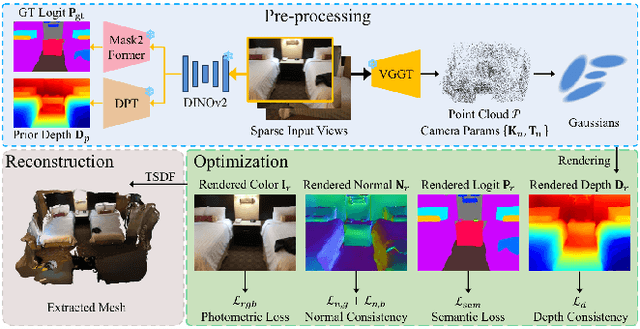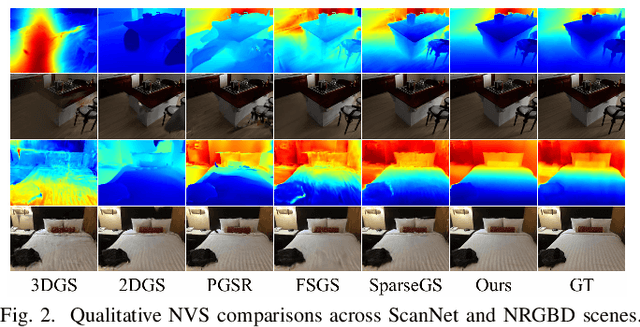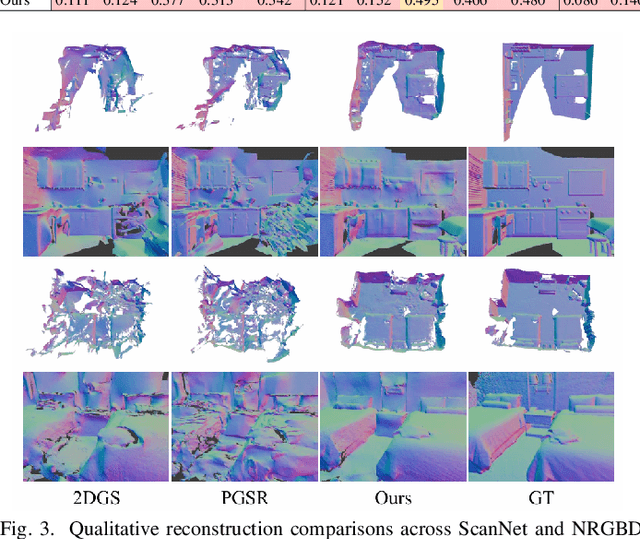Indoor Scene Reconstruction
Indoor scene reconstruction is the process of creating 3D models of indoor environments from images or videos.
Papers and Code
3D-RE-GEN: 3D Reconstruction of Indoor Scenes with a Generative Framework
Dec 19, 2025Recent advances in 3D scene generation produce visually appealing output, but current representations hinder artists' workflows that require modifiable 3D textured mesh scenes for visual effects and game development. Despite significant advances, current textured mesh scene reconstruction methods are far from artist ready, suffering from incorrect object decomposition, inaccurate spatial relationships, and missing backgrounds. We present 3D-RE-GEN, a compositional framework that reconstructs a single image into textured 3D objects and a background. We show that combining state of the art models from specific domains achieves state of the art scene reconstruction performance, addressing artists' requirements. Our reconstruction pipeline integrates models for asset detection, reconstruction, and placement, pushing certain models beyond their originally intended domains. Obtaining occluded objects is treated as an image editing task with generative models to infer and reconstruct with scene level reasoning under consistent lighting and geometry. Unlike current methods, 3D-RE-GEN generates a comprehensive background that spatially constrains objects during optimization and provides a foundation for realistic lighting and simulation tasks in visual effects and games. To obtain physically realistic layouts, we employ a novel 4-DoF differentiable optimization that aligns reconstructed objects with the estimated ground plane. 3D-RE-GEN~achieves state of the art performance in single image 3D scene reconstruction, producing coherent, modifiable scenes through compositional generation guided by precise camera recovery and spatial optimization.
A Modular Framework for Single-View 3D Reconstruction of Indoor Environments
Dec 17, 2025We propose a modular framework for single-view indoor scene 3D reconstruction, where several core modules are powered by diffusion techniques. Traditional approaches for this task often struggle with the complex instance shapes and occlusions inherent in indoor environments. They frequently overshoot by attempting to predict 3D shapes directly from incomplete 2D images, which results in limited reconstruction quality. We aim to overcome this limitation by splitting the process into two steps: first, we employ diffusion-based techniques to predict the complete views of the room background and occluded indoor instances, then transform them into 3D. Our modular framework makes contributions to this field through the following components: an amodal completion module for restoring the full view of occluded instances, an inpainting model specifically trained to predict room layouts, a hybrid depth estimation technique that balances overall geometric accuracy with fine detail expressiveness, and a view-space alignment method that exploits both 2D and 3D cues to ensure precise placement of instances within the scene. This approach effectively reconstructs both foreground instances and the room background from a single image. Extensive experiments on the 3D-Front dataset demonstrate that our method outperforms current state-of-the-art (SOTA) approaches in terms of both visual quality and reconstruction accuracy. The framework holds promising potential for applications in interior design, real estate, and augmented reality.
Joint Learning of Depth, Pose, and Local Radiance Field for Large Scale Monocular 3D Reconstruction
Dec 20, 2025Photorealistic 3-D reconstruction from monocular video collapses in large-scale scenes when depth, pose, and radiance are solved in isolation: scale-ambiguous depth yields ghost geometry, long-horizon pose drift corrupts alignment, and a single global NeRF cannot model hundreds of metres of content. We introduce a joint learning framework that couples all three factors and demonstrably overcomes each failure case. Our system begins with a Vision-Transformer (ViT) depth network trained with metric-scale supervision, giving globally consistent depths despite wide field-of-view variations. A multi-scale feature bundle-adjustment (BA) layer refines camera poses directly in feature space--leveraging learned pyramidal descriptors instead of brittle keypoints--to suppress drift on unconstrained trajectories. For scene representation, we deploy an incremental local-radiance-field hierarchy: new hash-grid NeRFs are allocated and frozen on-the-fly when view overlap falls below a threshold, enabling city-block-scale coverage on a single GPU. Evaluated on the Tanks and Temples benchmark, our method reduces Absolute Trajectory Error to 0.001-0.021 m across eight indoor-outdoor sequences--up to 18x lower than BARF and 2x lower than NoPe-NeRF--while maintaining sub-pixel Relative Pose Error. These results demonstrate that metric-scale, drift-free 3-D reconstruction and high-fidelity novel-view synthesis are achievable from a single uncalibrated RGB camera.
Quantum Implicit Neural Representations for 3D Scene Reconstruction and Novel View Synthesis
Dec 14, 2025Implicit neural representations (INRs) have become a powerful paradigm for continuous signal modeling and 3D scene reconstruction, yet classical networks suffer from a well-known spectral bias that limits their ability to capture high-frequency details. Quantum Implicit Representation Networks (QIREN) mitigate this limitation by employing parameterized quantum circuits with inherent Fourier structures, enabling compact and expressive frequency modeling beyond classical MLPs. In this paper, we present Quantum Neural Radiance Fields (Q-NeRF), the first hybrid quantum-classical framework for neural radiance field rendering. Q-NeRF integrates QIREN modules into the Nerfacto backbone, preserving its efficient sampling, pose refinement, and volumetric rendering strategies while replacing selected density and radiance prediction components with quantum-enhanced counterparts. We systematically evaluate three hybrid configurations on standard multi-view indoor datasets, comparing them to classical baselines using PSNR, SSIM, and LPIPS metrics. Results show that hybrid quantum-classical models achieve competitive reconstruction quality under limited computational resources, with quantum modules particularly effective in representing fine-scale, view-dependent appearance. Although current implementations rely on quantum circuit simulators constrained to few-qubit regimes, the results highlight the potential of quantum encodings to alleviate spectral bias in implicit representations. Q-NeRF provides a foundational step toward scalable quantum-enabled 3D scene reconstruction and a baseline for future quantum neural rendering research.
Radiance-Field Reinforced Pretraining: Scaling Localization Models with Unlabeled Wireless Signals
Dec 08, 2025Radio frequency (RF)-based indoor localization offers significant promise for applications such as indoor navigation, augmented reality, and pervasive computing. While deep learning has greatly enhanced localization accuracy and robustness, existing localization models still face major challenges in cross-scene generalization due to their reliance on scene-specific labeled data. To address this, we introduce Radiance-Field Reinforced Pretraining (RFRP). This novel self-supervised pretraining framework couples a large localization model (LM) with a neural radio-frequency radiance field (RF-NeRF) in an asymmetrical autoencoder architecture. In this design, the LM encodes received RF spectra into latent, position-relevant representations, while the RF-NeRF decodes them to reconstruct the original spectra. This alignment between input and output enables effective representation learning using large-scale, unlabeled RF data, which can be collected continuously with minimal effort. To this end, we collected RF samples at 7,327,321 positions across 100 diverse scenes using four common wireless technologies--RFID, BLE, WiFi, and IIoT. Data from 75 scenes were used for training, and the remaining 25 for evaluation. Experimental results show that the RFRP-pretrained LM reduces localization error by over 40% compared to non-pretrained models and by 21% compared to those pretrained using supervised learning.
RISE: Single Static Radar-based Indoor Scene Understanding
Nov 18, 2025Robust and privacy-preserving indoor scene understanding remains a fundamental open problem. While optical sensors such as RGB and LiDAR offer high spatial fidelity, they suffer from severe occlusions and introduce privacy risks in indoor environments. In contrast, millimeter-wave (mmWave) radar preserves privacy and penetrates obstacles, but its inherently low spatial resolution makes reliable geometric reasoning difficult. We introduce RISE, the first benchmark and system for single-static-radar indoor scene understanding, jointly targeting layout reconstruction and object detection. RISE is built upon the key insight that multipath reflections, traditionally treated as noise, encode rich geometric cues. To exploit this, we propose a Bi-Angular Multipath Enhancement that explicitly models Angle-of-Arrival and Angle-of-Departure to recover secondary (ghost) reflections and reveal invisible structures. On top of these enhanced observations, a simulation-to-reality Hierarchical Diffusion framework transforms fragmented radar responses into complete layout reconstruction and object detection. Our benchmark contains 50,000 frames collected across 100 real indoor trajectories, forming the first large-scale dataset dedicated to radar-based indoor scene understanding. Extensive experiments show that RISE reduces the Chamfer Distance by 60% (down to 16 cm) compared to the state of the art in layout reconstruction, and delivers the first mmWave-based object detection, achieving 58% IoU. These results establish RISE as a new foundation for geometry-aware and privacy-preserving indoor scene understanding using a single static radar.
Room Envelopes: A Synthetic Dataset for Indoor Layout Reconstruction from Images
Nov 06, 2025Modern scene reconstruction methods are able to accurately recover 3D surfaces that are visible in one or more images. However, this leads to incomplete reconstructions, missing all occluded surfaces. While much progress has been made on reconstructing entire objects given partial observations using generative models, the structural elements of a scene, like the walls, floors and ceilings, have received less attention. We argue that these scene elements should be relatively easy to predict, since they are typically planar, repetitive and simple, and so less costly approaches may be suitable. In this work, we present a synthetic dataset -- Room Envelopes -- that facilitates progress on this task by providing a set of RGB images and two associated pointmaps for each image: one capturing the visible surface and one capturing the first surface once fittings and fixtures are removed, that is, the structural layout. As we show, this enables direct supervision for feed-forward monocular geometry estimators that predict both the first visible surface and the first layout surface. This confers an understanding of the scene's extent, as well as the shape and location of its objects.
SenseRay-3D: Generalizable and Physics-Informed Framework for End-to-End Indoor Propagation Modeling
Nov 15, 2025Modeling indoor radio propagation is crucial for wireless network planning and optimization. However, existing approaches often rely on labor-intensive manual modeling of geometry and material properties, resulting in limited scalability and efficiency. To overcome these challenges, this paper presents SenseRay-3D, a generalizable and physics-informed end-to-end framework that predicts three-dimensional (3D) path-loss heatmaps directly from RGB-D scans, thereby eliminating the need for explicit geometry reconstruction or material annotation. The proposed framework builds a sensing-driven voxelized scene representation that jointly encodes occupancy, electromagnetic material characteristics, and transmitter-receiver geometry, which is processed by a SwinUNETR-based neural network to infer environmental path-loss relative to free-space path-loss. A comprehensive synthetic indoor propagation dataset is further developed to validate the framework and to serve as a standardized benchmark for future research. Experimental results show that SenseRay-3D achieves a mean absolute error of 4.27 dB on unseen environments and supports real-time inference at 217 ms per sample, demonstrating its scalability, efficiency, and physical consistency. SenseRay-3D paves a new path for sense-driven, generalizable, and physics-consistent modeling of indoor propagation, marking a major leap beyond our pioneering EM DeepRay framework.
Terra: Explorable Native 3D World Model with Point Latents
Oct 16, 2025World models have garnered increasing attention for comprehensive modeling of the real world. However, most existing methods still rely on pixel-aligned representations as the basis for world evolution, neglecting the inherent 3D nature of the physical world. This could undermine the 3D consistency and diminish the modeling efficiency of world models. In this paper, we present Terra, a native 3D world model that represents and generates explorable environments in an intrinsic 3D latent space. Specifically, we propose a novel point-to-Gaussian variational autoencoder (P2G-VAE) that encodes 3D inputs into a latent point representation, which is subsequently decoded as 3D Gaussian primitives to jointly model geometry and appearance. We then introduce a sparse point flow matching network (SPFlow) for generating the latent point representation, which simultaneously denoises the positions and features of the point latents. Our Terra enables exact multi-view consistency with native 3D representation and architecture, and supports flexible rendering from any viewpoint with only a single generation process. Furthermore, Terra achieves explorable world modeling through progressive generation in the point latent space. We conduct extensive experiments on the challenging indoor scenes from ScanNet v2. Terra achieves state-of-the-art performance in both reconstruction and generation with high 3D consistency.
AlignGS: Aligning Geometry and Semantics for Robust Indoor Reconstruction from Sparse Views
Oct 09, 2025



The demand for semantically rich 3D models of indoor scenes is rapidly growing, driven by applications in augmented reality, virtual reality, and robotics. However, creating them from sparse views remains a challenge due to geometric ambiguity. Existing methods often treat semantics as a passive feature painted on an already-formed, and potentially flawed, geometry. We posit that for robust sparse-view reconstruction, semantic understanding instead be an active, guiding force. This paper introduces AlignGS, a novel framework that actualizes this vision by pioneering a synergistic, end-to-end optimization of geometry and semantics. Our method distills rich priors from 2D foundation models and uses them to directly regularize the 3D representation through a set of novel semantic-to-geometry guidance mechanisms, including depth consistency and multi-faceted normal regularization. Extensive evaluations on standard benchmarks demonstrate that our approach achieves state-of-the-art results in novel view synthesis and produces reconstructions with superior geometric accuracy. The results validate that leveraging semantic priors as a geometric regularizer leads to more coherent and complete 3D models from limited input views. Our code is avaliable at https://github.com/MediaX-SJTU/AlignGS .
 Add to Chrome
Add to Chrome Add to Firefox
Add to Firefox Add to Edge
Add to Edge